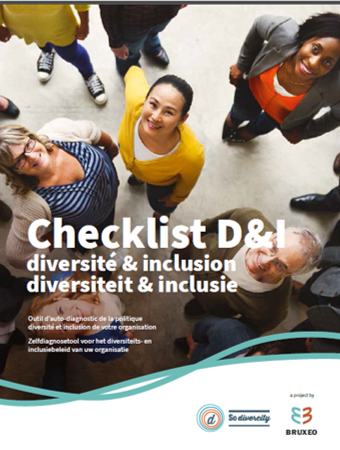
Performing a DEI scan.


A Diversity, Equity, and Inclusion scan is a way of transforming data into understanding. You set up quantitative and qualitative measuring to get an accurate view of your organization’s current diversity and equity. And of the feelings of inclusion that employees experience.
Why measure
WHY MEASURE
There are four reasons to set up a DEI Scan:
- Map the “as is” situation with an understanding of root causes.
- Identify the most significant gaps and critical areas of attention.
- Identify the organization’s strengths and capabilities to make progress.
- Build a sustainable model to measure and report progress.
What to analyze
WHAT TO ANALYZE
You should measure different aspects to get a comprehensive image of what your organization looks like:
- Diversity in the organization, your partners’ organizations, stakeholders, and candidate pool.
- Equity both in the organization’s policies and in the way these policies translate into practices
- Inclusion by measuring and inquiring about feelings of belonging
Each of these three elements requires a different way of collecting and analyzing data. There are two main types of data: quantitative (information that can be quantified, counted, or measured and given a numerical value) and qualitative data (descriptive, expressed in terms of language rather than numerical values). Below you will find four ways of collecting data to create your own DEI scan.
Collecting & Analyzing data
COLLECTING & ANALYZING DATA
It’s essential to ensure that any data collection you do, is in full compliance with EU General Data Protection Regulation (GDPR) and national data protection rules. In line with the GDPR, data should not be published or publicly accessible in a manner that allows the identification of individual data subjects, either directly or indirectly. You can find more info from the European Commission on collecting data in line with GDPR here.
A quantitative analysis of HR data will help uncover DEI red flags, priorities, and knowledge gaps and allow you to measure future progress.
Collect data from a defined period regarding:
- Population, board & management: What does our employee population look like regarding gender, age, seniority, ethnicity, sexual orientation, and caregiver status?
- Recruitment, talent development & promotion: What can we learn from our current recruitment, talent development, and promotion processes? Who is a top talent? What does our talent flow look like?
- Attrition and employee turnover: What are our attrition and employee turnover rates? Do we capture reasons for leaving (for example, through exit interviews)?
- Equal pay: Do we have pay equality at all levels? Besides gender, are there other socio-demographics to take into account?
- Flexibility: Which work schedules are most common? Do employees use our flexible work options, do they take parental leave?
To keep the data easy to analyze, try defining a maximum of five levels in the organization. Make an overview of the functions/job categories/seniorities in each level. That will provide clarity for team members working on the scan.
- Top management = …
- Higher management = …
- Middle management = …
- Junior management = …
- Operational = …
Zoom in on different socio-demographic groups. Dig deep and try different cross-analyses to gain insight into how your organization is or is not providing equal access to opportunities for specific groups of employees.
You can also define (groups of) departments, clearly distinguishing between key and other business departments/support functions.
Other DEI metrics that your organization can collect and track are metrics on equal pay, employee turnover, retention, promotion, etc. You can find more info in this article by AIHR.
When setting up a scan, work out a good data collection process. That will make repeating the scan regularly more efficient.
Reflect on the following questions:
- Who has access to the data we need?
- Is the information already anonymous, or do we need someone to clean the dataset?
- Do we have a clear template that reflects the analysis we want to do, allowing us to start working with the data instantly?
As your organization’s staff grows in time, the need for policies that guarantee equal opportunities increases, and DEI principles become more formally integrated into policies.
Policies can relate to recruitment, selection and onboarding, talent development, equal pay, learning and development, career planning, flexibility in the organization of work, top management endorsement, integration of DEI in the business, and DEI resources.
Discover more about the policies you need and how to implement them here.
Having well-defined policies does not guarantee good practices. Reflect on the following questions:
- Which policies regarding diversity, equal opportunities & inclusion do you have?
- Are the policies clear?
- Do they reach their intended goal?
- How is each policy put into practice?
- What is the most common practice for each policy?
- Does it align with or contradict the policies’ intentions?
- Do practices differ depending on department, level, team, or leader?
- How do they differ?
- Does this lead to a lack of equality in the organization?
- What barriers to equal implementation of policies are there?
- What is needed to overcome these barriers?
Use the tools listed below to take a closer look at your current policies and analyze their practice.
Do this exercise with multiple people in different departments and roles throughout the organization. You will quickly notice how everyone experiences the organization’s policies and practices differently.
Having diverse points of view around the table will help you paint the most accurate picture.
A company-wide inclusion survey allows you to ask all employees about their experiences and attitudes towards in/exclusion at work. If you ask the right questions and gather enough responses, a survey will help quantify feelings of inclusion and uncover red flags and DEI priorities.
A survey creates an opportunity to:
- Spotlight and kick off your company’s engagement with DEI.
- Engage employees in DEI and welcome their input.
- Create a safe space for employees to voice their opinion.
- Validate employee experiences and make them feel heard.
Not sure where to start when composing your list of questions?
- Get inspiration from SurveyMonkey’s DEI-related survey templates.
- Engage an expert like Inclusion Now. The guidance in choosing questions, checking language for inclusivity, setting up communication, etc., will help ensure a psychologically safe environment for participants to share their experiences. That will increase response rates and the quality of responses.
Some best practices for surveys are:
- Select 20 to 25 content questions.
- Foresee a maximum of 10 minutes to complete the survey.
- Start and end with easy questions to create a pleasant experience.
- Make sure to use inclusive language.
At the start of the survey:
- Clarify why you set up this survey.
- Define key terms to ensure a clear understanding of the questions.
- Guarantee complete anonymity for participants.
At the end of the survey, add optional socio-demographic questions:
- Explain why this data is essential: To differentiate gender, age, ethnicity, (dis)ability, caregiver group answers, departments, levels, and (leadership)roles. They allow you to uncover possible red flags or areas of improvement for specific employee groups.
- Inquiring about demographics can feel personal and invasive but can also validate different identity elements that determine personal experiences at work (e.g., age, gender, ethnicity).
- People are no more likely to skip these questions than any other if answer options are inclusive and not mandatory.
Organizations often integrate some inclusion-related questions into their annual wellbeing or employee satisfaction survey. That is a limited way of gathering information used to get a first impression or, in the case of survey fatigue. It does not allow for in-depth analysis.
Creating a separate survey is always worth it. It gives you the opportunity to:
- Ask more content questions.
- Touch upon all aspects contributing or forming barriers to inclusion.
- Gather more data, resulting in more accurate and detailed insights.
- Provide more opportunities for employees to share experiences, and make them feel heard.
- Ask about socio-demographic characteristics.
- Get a better sense of the diversity in your employee population.
- Cross-analyze content questions about socio-demographics to identify specific groups answering questions more positively or negatively.
Once your survey is closed, and the results are analyzed, don’t forget to communicate. Employees have invested time and effort and expect results and insights in return.
Provide a high-level overview of the results, positive aspects, and areas for improvement. Try to link them to your DEI Strategic Plan. The survey’s outcome motivates the DEI topics you prioritize in your strategy.
Clear communication will motivate employees to complete your Inclusion Survey in the future and, most notably, to support your DEI efforts.
It is helpful to have concrete examples of practices or behaviors in the organization considered to be experiences of exclusion or inequality. To gather these stories, conduct in-depth interviews with:
Inquire about the company culture of belonging, respect, acknowledgment, collaboration, feedback, leadership, talent development & career opportunities. Choose your questions based on the red flags that surfaced in the Inclusion Survey.
Before you start the interview, always provide context. Explain why you are conducting interviews, who will have access to the transcripts, and whom you will share your conclusions with.
Asking about experiences of inclusion or exclusion is a delicate matter. It can be difficult for employees to trust internal interviewers with their personal stories.
Involve a DEI expert in the interviews. Having an interviewer with no direct link to leaders or colleagues in the organization will make interviewees feel safe. Besides expertise in conducting interviews, knowing which follow-up questions to ask and how to formulate them in a non-leading way, an external partner can guarantee complete anonymity in reporting.
You will gather the most valuable information when the list of interview questions is set and tailor-made to your organization. Partner with experts like Inclusion Now to select the most relevant questions, conduct the interviews, and process and report input from a DEI point of view.
Further steps
FURTHER STEPS
After you have successfully collected and analyzed the data, don’t forget these essential last steps:
- Merge the results from all data sources to determine your organization’s maturity level regarding DEI and to create your DEI story. Benchmarking with industry standards can help situate your organization.
- Present the results to your top leadership and communicate the outcome of the DEI scan in an accessible way.
- Repeat the analysis annually to measure evolution.
While reporting on the results of the scan, don’t forget to frame DEI using a positive perspective of creating an inclusive workplace where all talents can thrive.
DEI facts and figures in tech
TOOLS
Become a DEI expert.
This is a collection of articles that allows you to take a deep dive.

Self-assessment tool on Diversity & Inclusion – DIGNA

How to Best Use Data to Meet Your DE&I Goals
DEI metrics that really matter (whitepaper).

Why (and how!) to ask survey questions on gender identity and sexual orientation | SurveyMonkey
.jpg#keepProtocol)
Diversity in Tech 2021 Report

10 tips to improve your online surveys | SurveyMonkey






